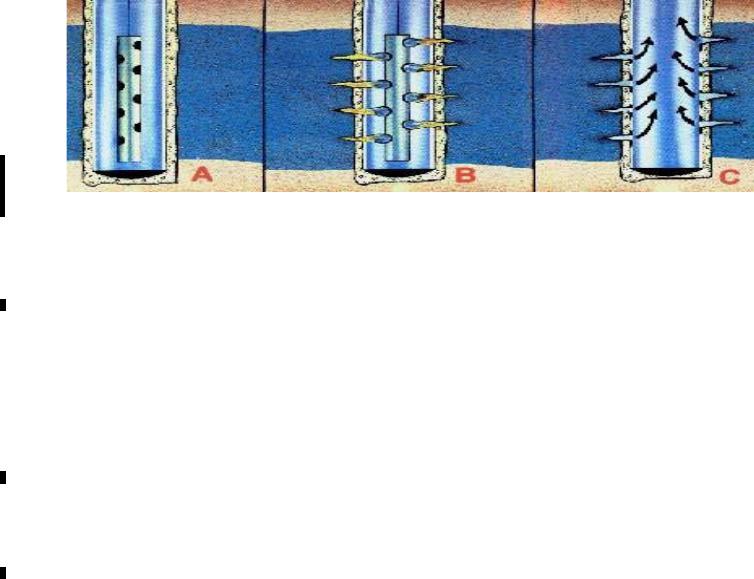
Chapter_6-OCW
.pdf
Perforation
Perforating gun (WCP type) is lowered into the hole at the depth where the oil or gas formation is found (A).
After the gun is lined up properly, powerful explosive charges are fired (B) from the control panel at the surface. These explosives blast a hole in the steel casing and cement, up to several feet out into the rock.
Finally, the oil and gas fluids flow into the holes and up the well to the surface (C).

Perforating Fluid
Is a fluid that placed against the producing formation during perforation.
Ideally, fluid with no solids.
Fluids to be considered:
Salt water: Clean water poses no problem. When overbalanced, may push charge debris into formation.
Acetic acid: Excellent perforating fluid under most
conditions. The presence of H2S may magnify corrosion problems.
Nitrogen: Useful in low pressure formations, or when associated with high rig time or swabbing costs, or when a special test requires formation to be free from contamination.

Wellhead Assembly
Comprise x-mas tree, casing head, and tubing head. Wellhead is referred to casing head and tubing head.
X-mas tree is installed on top of the wellhead.
Tubing head in located above the casing head.

Well Stimulation
Sometime, petroleum exists in a formation but is unable to flow readily into the well because the formation has very low permeability.
–Natural low permeability formation.
–Formation damage around the wellbore caused by invasion of perforation fluid and charge debris.
Acidizing or fracturing is a methods used to increase the permeability near the wellbore.

Acidizing
If the formation is composed of rocks that dissolve upon being contacted by acid, such as limestone or dolomite, then a technique known as acidizing may be required.
Acidizing operation basically consists of pumping from fifty to thousands of gallons of acid down the well.
The acid travels down the tubing, enters the perforations, and contacts the formation.

Acidizing
Continued pumping forces the acid into the formation where it produces channels.
Channels will provide a way for the formation’s oil or gas to enter the well through the perforations.
The most common acid systems in use are:
Hydrochloric Acid: This is the most widely used acid in treatments, with concentrations ranging between 7.5% and 28%, the most common is 15%. It will dissolves Calcium Carbonate (CaCO3), Dolomite (CaMgCO3), Siderite (FeCO3), and Iron Oxide (Fe2O3).

Acidizing
Mud Acid: This is a mixture of HCl and HF (hydrofluoric acid) and is generally 12% HCl and 3% HF. It will dissolve clay materials in the formation, along with feldspars and quartz. The HF will react with Na, K, Ca and Si in the clays to form insoluble precipitates, so it is advisable to always preflush with HCl.
Organic Acids: These are Acetic and Formic Acids. They are slower acting than HCl, and are generally used in high temperature wells and wells with high alloy tubing to reduce corrosion rates.
EDTA: This is Ethylene Diamine Tetra-Acetic Acid. It dissolves carbonates and sulphates by chelating them. It is more expensive than the other acids and the reaction is slower.

Fracturing
Fracturing is a process to increase the permeability of reservoir rocks (eg sandstone) by pumping a special blended fluid down the well and into the formation under great pressure.
Pumping continues until the downhole pressure exceeding fracture pressure of the rocks, formation literally cracks open (with opening between 0.25 – 0.5 inch).
Meanwhile, sand or aluminum pellets are mixed into the fracturing fluid. These materials are called proppants.
The proppant enters the fractures in the formation, and, when pumping is stopped and the pressure decreased, the proppant remains in the fractures

Fracturing
Since the fractures try to close back together after the pressure on the well is released, the proppant is needed to hold fractures open.
These propped-open fractures is permeable enough to provide passages for oil or gas to flow into the well.
